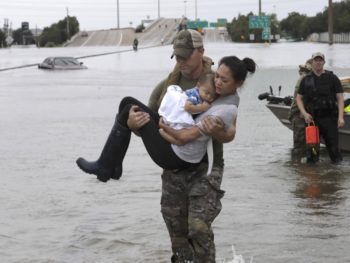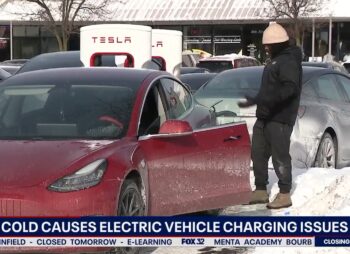
Taking a look at the recent literature, we find a paper authored by Ryan Truchelut and Erica Staehling appearing in the Geophysical Research Letters on December 8, 2017. They looked at the development of American hurricanes based on accumulated cyclone energy (ACE).
CO2 and hurricanes are not connected
The two authors found a statistically significant reduction in hurricane activity over the past 65 years. The relative inactivity of the past years (except for the very active 2017 season) was the most inactive phase of the examined time period. The abstract (emphasis added):
An Energetic Perspective on United States Tropical Cyclone Landfall Droughts
The extremely active 2017 Atlantic hurricane season concluded an extended period of quiescent continental United States tropical cyclone landfall activity that began in 2006, commonly referred to as the landfall drought. We introduce an extended climatology of U.S. tropical cyclone activity based on accumulated cyclone energy (ACE) and use this dataset to investigate variability and trends in landfall activity. The drought years between 2006 and 2016 recorded an average value of total annual ACE over the U.S. that was less than 60% of the 1900–2017 average. Scaling this landfall activity metric by basin-wide activity reveals a statistically significant downward trend since 1950, with the percentage of total Atlantic ACE expended over the continental U.S. at a series minimum during the recent drought period.”
As CO2 in the atmosphere continues to rise unabated, hurricane activity is decreasing. Obviously, the two trends have little to do with each other.
Experts advise caution in assigning blame
Looking at the very clear body of facts, it is little wonder that the NOAA (via the Geophysical Fluid Dynamics Laboratory, GFDL) cautioned against linking the greenhouse gases and hurricanes in an official statement:
It is premature to conclude that human activities–and particularly greenhouse gas emissions that cause global warming–have already had a detectable impact on Atlantic hurricane or global tropical cyclone activity. That said, human activities may have already caused changes that are not yet detectable due to the small magnitude of the changes or observational limitations, or are not yet confidently modeled (e.g., aerosol effects on regional climate).”
Shrill in Potsdam
However, in Germany, scientists at the Potsdam Institute for Climate Impact Research (PIK) don’t accept the facts for what they are. For them, it’s more important to be shrill and to set off alarms. For example in the wake of Hurricane Harvey, PIK scientist Anders Levermann gave a radio interview at Radio Eins on September 1, 2017. He said that when it’s warmer, more water vapor ends up in the air, and thus more rain and a hurricane with a flooding catastrophe in Houston. It’s just that simple, right? Then later in the interview, Levermann added a “maybe.”
What Levermann committed here, of course, was an irresponsible misleading of the listeners. The clear decrease in hurricanes over the past 65 years contradicts his extraordinarily simplistic claims.
Poor urban planning
At the BBC the journalists were more serious with the subject and did not stay silent regarding the complexity that is involved as it is known that a vast number of factors are at play. In Houston, for example, a blocking pattern was at work and thus led to a heavy rainfall over an urban area for a protracted time period. Anyone who claims that a part of the disaster can be attributed to man is unrealistically simplifying the system and ought to know better.
The answer to the question as to what the problem in Houston was is provided by an article by the BBC:
Climate change did not make people build along a vulnerable coastline so the disaster itself is our choice and is not linked to climate change.”
On ARD German public television, they too have gotten much more careful. TV meteorologist Donald Bäcker flatly dismissed the shot from the hip from Potsdam.
Forecasts thanks to link to AMO
In June 2017, at the start of the hurricane season, Judith Curry and CFAN published a prognosis for the hurricane season. Here they anticipated an above-average hurricane activity season. They were right. If they are successful next year as well, then we’ll have an important forecasting method that will be of great use for society.
Other prognoses: Hurricanes have a certain development. Satellite photos allow the creation of storms to be tracked. But not all West African hurricane babies make it across the Atlantic and reach America. Tel Aviv University developed a model that allows us to determine which storms pose a risk and which ones will die off. Read the press release here.
Over the mid-term, hurricane activity can be forecast quite well because it is closely coupled to the Atlantic Multidecadal Oscillation (AMO) ocean cycle, which has a periodicity of about 60 years. Michel de Rougemont reminds us in an essay appearing at WUWT.
Building in flood-prone areas is negligent
In Germany’s leading political daily FAZ of August 31, 2017, Winand von Petersdorff pointed out an important damage factor related to Hurricane Harvey. It was a man-made disaster in the sense that many homes and buildings had been built in classic flood-prone areas.
The enormous costs were foremost caused by the fact that the booming Houston metropolitan area, with its 6.5 million inhabitants, permitted building in grand style in areas where flooding and high water would occur.”
Read more at No Tricks Zone

















back in 1969 the year we landed on the moon Hurricane Camel cuased many deaths but by far Americas deadists Hurricane was the Galveston Hurricane in 1900